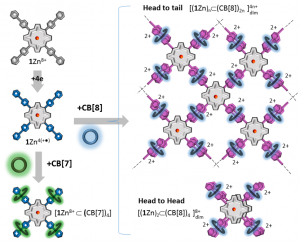Photo/Redox-Responsive 2D-Supramolecular Assembly Involving Cucurbit[8]uril and a Star-Shaped Porphyrin Tecton
Our article is available to read at Electrochim. Acta
 The present paper reports on the formation and on the electrochemical/spectroscopic characterization of inclusion complexes formed in aqueous media between cucurbit[7 or 8]urils cavitands (CB[7], CB[8]) and a rigid four-pointed star-shaped viologen-appended porphyrin tecton. The formation of discrete 4:1 pseudo-rotaxane-like caviplexes, involving threading of CB[n] rings on the rigid viologen-based star’s branches has been demonstrated by nuclear magnetic resonance and mass spectrometry measurements. Then, the photo- and redox-triggered formation of 2D supramolecular assemblies involving CB[8]s and the four electron reduced tectons as key building elements, has been established on the ground of in-depth electrochemical and spectroscopic analyses supported by quantum calculations. The CB[8]-promoted intermolecular π-dimerization of the viologen cation radicals introduced at the meso positions of the porphyrin plateform has been brought to light through the diagnostic signatures of the 1:2 host-guest ternary caviplexes formed between viologen and CB[8] and by spectroscopic data collected after electrochemical, chemical or photochemical reduction of the viologen-based tectons. The CB[8] hosts not only proved useful to promote the redox-triggered formation of supramolecular assemblies, it was also found to prevent the chemical reduction of the porphyrin ring in aqueous media and its subsequent conversion into phlorin products.
The present paper reports on the formation and on the electrochemical/spectroscopic characterization of inclusion complexes formed in aqueous media between cucurbit[7 or 8]urils cavitands (CB[7], CB[8]) and a rigid four-pointed star-shaped viologen-appended porphyrin tecton. The formation of discrete 4:1 pseudo-rotaxane-like caviplexes, involving threading of CB[n] rings on the rigid viologen-based star’s branches has been demonstrated by nuclear magnetic resonance and mass spectrometry measurements. Then, the photo- and redox-triggered formation of 2D supramolecular assemblies involving CB[8]s and the four electron reduced tectons as key building elements, has been established on the ground of in-depth electrochemical and spectroscopic analyses supported by quantum calculations. The CB[8]-promoted intermolecular π-dimerization of the viologen cation radicals introduced at the meso positions of the porphyrin plateform has been brought to light through the diagnostic signatures of the 1:2 host-guest ternary caviplexes formed between viologen and CB[8] and by spectroscopic data collected after electrochemical, chemical or photochemical reduction of the viologen-based tectons. The CB[8] hosts not only proved useful to promote the redox-triggered formation of supramolecular assemblies, it was also found to prevent the chemical reduction of the porphyrin ring in aqueous media and its subsequent conversion into phlorin products.